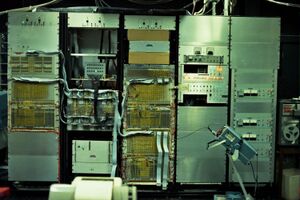Difference between revisions of "BCC 500"
From Computer History Wiki
(Move BCC content content to a BCC page) |
m (→External links: +Some Remarks on a Large New Time-Sharing System) |
||
| Line 12: | Line 12: | ||
* [http://www.bitsavers.org/pdf/univOfHawaii/ University of Hawaii] - more | * [http://www.bitsavers.org/pdf/univOfHawaii/ University of Hawaii] - more | ||
** [http://www.bitsavers.org/pdf/univOfHawaii/R-1_BCC500_DesignFeatures_Rev_Mar74.pdf Design Features of the BCC 500 CPU] | ** [http://www.bitsavers.org/pdf/univOfHawaii/R-1_BCC500_DesignFeatures_Rev_Mar74.pdf Design Features of the BCC 500 CPU] | ||
| + | * [http://bwlampson.site/06a-BCC500Notes/06a-BCC500Notes.pdf Some Remarks on a Large New Time-Sharing System] | ||
| + | * [http://bwlampson.site/06-DynamicProtect/06-DynamicProtect.pdf Dynamic protection structures] | ||
[[Category: Mainframes]] | [[Category: Mainframes]] | ||
Revision as of 21:41, 10 June 2023
The BCC 500 was a computer made by the Berkeley Computer Corporation. When the company went bankrupt, the prototype went to Hawaii and was successfully deployed as an ARPANET host. It was also the hub of the ALOHA network which inspired Ethernet.
The computer consists of six independent microcoded processors, having a 24-bit word width, 18-bit addressing, and access to a shared memory. The microcode implements a machine code with a 6-bit opcode and 18-bit address field. Two of the processors have expanded hardware capabilities and run user code. The other four are each responsible for implementing their own part of the operating system; part in microcode and part in macrocode.
